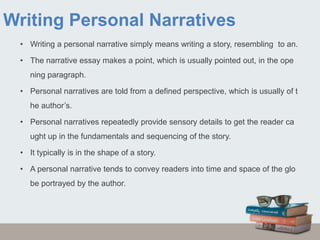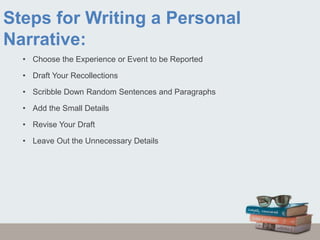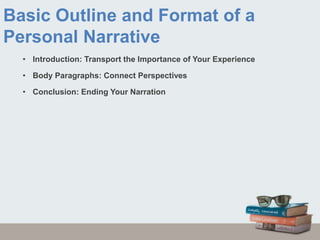Personal narrative - How to write a personal narrative?
- 1. HOW TO WRITE A PERSONAL NARRATIVE ?
- 2. Content 1. Definition of a Personal Narrative 2. Writing Personal Narratives 3. Famous Personal Narrative Examples 4. Steps for Writing a Personal Narrative 4.0.1. Choose the Experience or Event to be Reported 4.0.2. Draft Your Recollections 4.0.3. Scribble Down Random Sentences and Paragraphs 4.0.4. Add the Small Details 4.0.5 Revise Your Draft 4.0.6 Leave Out the Unnecessary Details 5. Basic Outline and Format of a Personal Narrative 5.0.1. Introduction: Transport the Importance of Your Experience 5.0.2. Body Paragraphs: Connect Perspectives 5.0.3 Conclusion: Ending Your Narration 5.1 Personal Narrative Ideas and Topics 5.2 Personal Narrative Writing Prompts
- 3. Definition ŌĆ£A personal account which offers details, analysis and a personal opinio n from a particular happening or event, experienced by the writerŌĆØ.
- 4. Writing Personal Narratives ŌĆó Writing a personal narrative simply means writing a story, resembling to an. ŌĆó The narrative essay makes a point, which is usually pointed out, in the ope ning paragraph. ŌĆó Personal narratives are told from a defined perspective, which is usually of t he authorŌĆÖs. ŌĆó Personal narratives repeatedly provide sensory details to get the reader ca ught up in the fundamentals and sequencing of the story. ŌĆó It typically is in the shape of a story. ŌĆó A personal narrative tends to convey readers into time and space of the glo be portrayed by the author.
- 5. Famous Personal Narrative Examples ŌĆó By Donald R. Burgett ŌĆó By Edward L. Beach ŌĆó By Roger Hilsman ŌĆó By Anne Frank ŌĆó By Jeannette Walls ŌĆó By Devin Scillian ŌĆó By Jane Yolen ŌĆó By Caroline Knapp ŌĆó By Ji-li Jiang
- 6. Steps for Writing a Personal Narrative: ŌĆó Choose the Experience or Event to be Reported ŌĆó Draft Your Recollections ŌĆó Scribble Down Random Sentences and Paragraphs ŌĆó Add the Small Details ŌĆó Revise Your Draft ŌĆó Leave Out the Unnecessary Details
- 7. Choose the Experience or Event to be Reported Keep these three basic principles in mind: ŌĆó Remember the audience that you will be writing for. A better narrativ e is one that interestingly recreates an incident for its readers rather than plai nly telling the story. ŌĆó Ensure that your experience is meaningful to the readers. For this to hold tru e, find a generalization that your story supports. This generalization does n ot necessarily have to include the entire humanity; it can target a particular ag e group or people from a specific background. ŌĆó Bear in mind that the story that you are going to write about is not plainly a story to be told, it has to have a meaning and must provide details clearl y as to support, explain and enhance the story.
- 8. Draft Your Recollections ŌĆó Now, spend enough time on drafting your recollections about the details of you r experience. ŌĆó Here is the time to create an outline of the basic parts of your narrative.
- 9. Scribble Down Random Sentences and Paragraphs ŌĆó Explain each part of your narrative. ŌĆó Rather than telling the audience dryly of what happened, try to recreate the experience creating life into it. ŌĆó For this, it is important to think like the audience because the information that you present is the only one that they have got.
- 10. Add the Small Details ŌĆó Also, keep in mind that the minute details that might seem unimportant to you are not necessarily going to be unimportant to the readers. ŌĆó Those details might spice up your personal narrative.
- 11. Revise Your Draft ŌĆó After completing the first draft, read your narrative as to have an idea whether the entire point has been clearly made and whether the experience is recreate d through the writing. ŌĆó Present your narrative to others and get possible advice and opinion of whe ther they think you have made your point in the entire piece or not.
- 12. Leave Out the Unnecessary Details ŌĆó Identify areas where more information and details are needed, cut off from pla ces where additional information is somewhat making the narrative seem less appealing. ŌĆó Rewrite the entire narrative clearing out the mistakes that have been pointed out. Once you are done with the second draft, there are fewer chances of furth er errors.
- 13. Basic Outline and Format of a Personal Narrative ŌĆó Introduction: Transport the Importance of Your Experience ŌĆó Body Paragraphs: Connect Perspectives ŌĆó Conclusion: Ending Your Narration
- 14. Introduction: Transport the Importance of Your Experience ŌĆó It is ideal to begin with a paragraph that will introduce the experience and will c ommunicate its significance. This technique promises that your audience will know how important the experience is to you, as the author, as they go thr ough the entire piece. ŌĆó Another effective technique is to begin your narrative right away and explainin g its significance at the very end. This approach allows the reader to develop t heir own perspective and give a suitable importance to the experience on the ir own.
- 15. Body Paragraphs: Connect Perspectives ŌĆó Provide a later explanation in the body paragraphs where you explain abo ut the significance and how important it is to you. ŌĆó This will help your readers to connect both perspectives. ŌĆó This approach might connect a great deal of significance to your experi ence.
- 16. Conclusion: Ending Your Narration ŌĆó End your personal narrative by telling the readers the deduction, analysis or effect on your life or thoughts of the experience.
- 17. Personal Narrative Ideas and Topics Following are a few personal narrative ideas and topics to help you get started on your narrative writing. ŌĆó A childhood memory ŌĆó Achieving a goal ŌĆó A failure ŌĆó An event that caused a prominent change in your life ŌĆó A realization ŌĆó My best friend ŌĆó The biggest mistake I have ever made ŌĆó The most embarrassing moment in my life ŌĆó My happiest moment in my life
- 18. Personal Narrative Writing Prompts ŌĆó Scary experiences Interesting happenings ŌĆó Joyful moments Success stories ŌĆó Changing places Inspiration ŌĆó Seasons Hard timings ŌĆó Celebratory moments Admiration


















